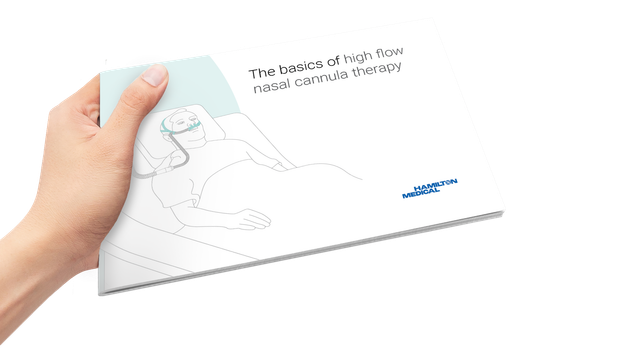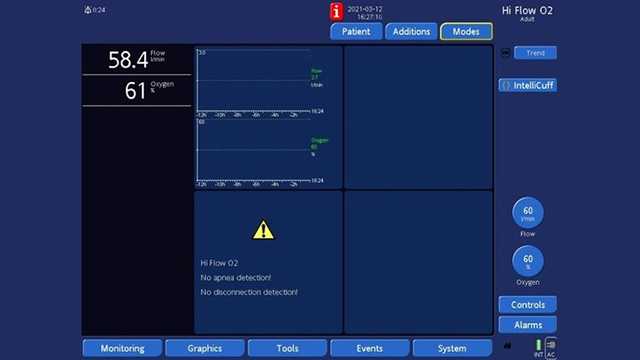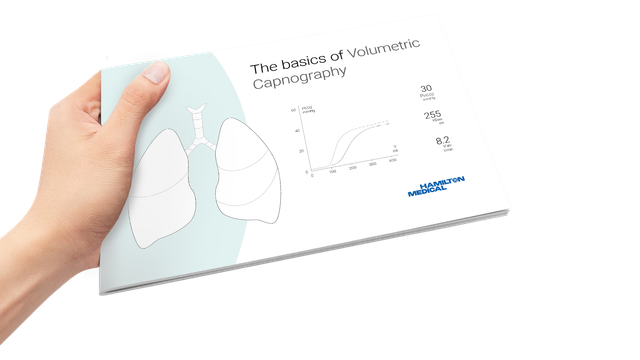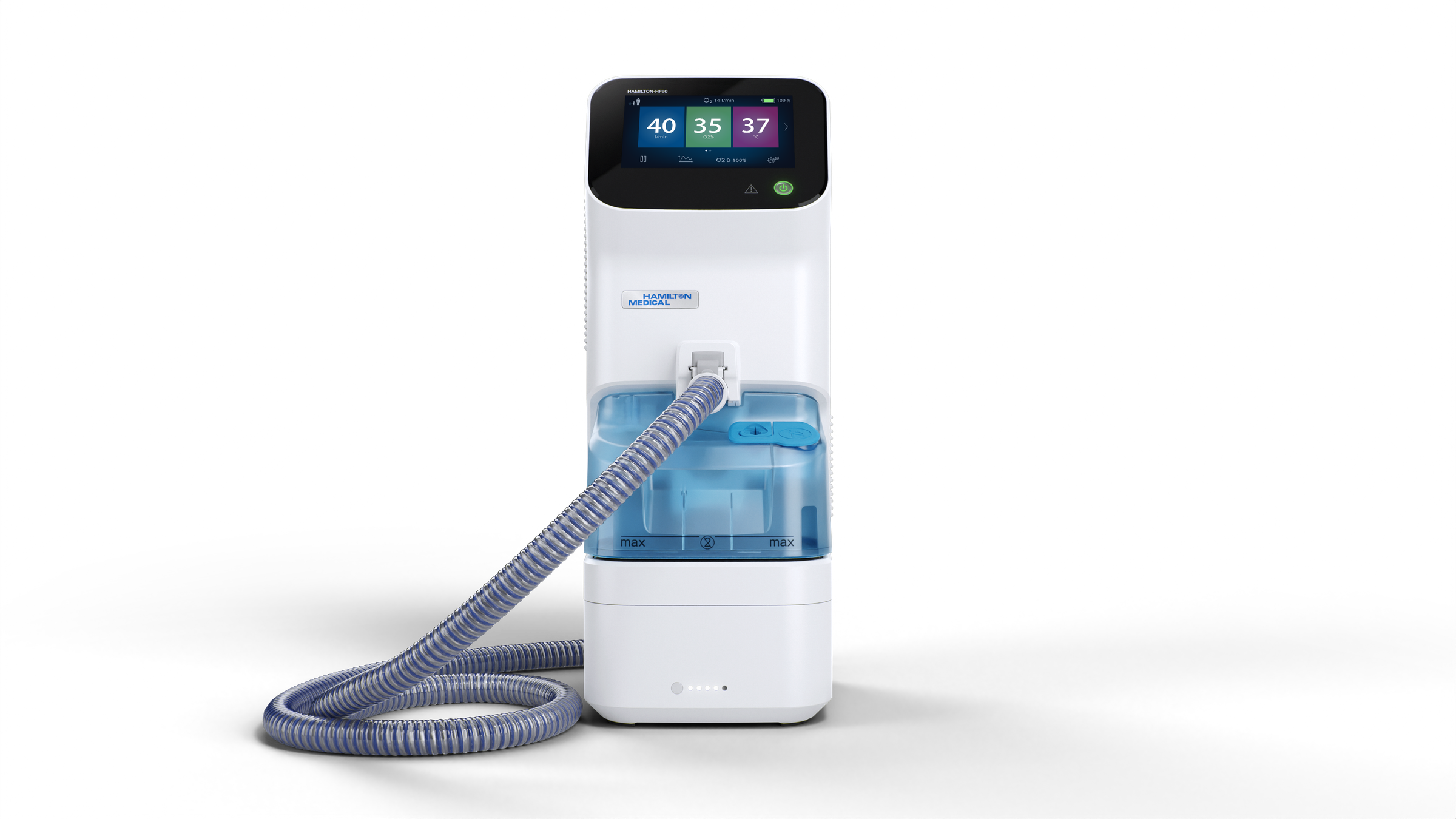
Author: Aude Garnero, Intensivist, Hôpital Sainte Musse, Toulon, France
Date of first publication: 04.05.2021
High‑flow therapy (HFT) is a non‑invasive form of respiratory support that can lower the intubation rate and mortality in patients with acute hypoxemic respiratory failure (AHRF) (1). Driven by concerns about the exposure of healthcare workers, initial recommendations discouraged the use of HFT in COVID‑19 patients (2, 3).

Takeaway messages
- Although initial recommendations discouraged the use of high flow therapy in COVID‑19 patients, high mortality rates in mechanically ventilated patients resulted in its gradual implementation.
- HFT has been used in COVID‑19 pneumonia related AHRF with favorable effects on oxygenation and evidence suggests it may decrease the need for mechanical ventilation and its duration.
- If appropriate personal protective equipment is used and cohorting precautions are taken, HFT may be applied in COVID‑19 patients without leading to a measurable increase in COVID‑19 infections in healthcare workers.
However, due to the high morbidity and mortality resulting from early invasive mechanical ventilation (
Physiologic effects
The physiologic effects of HFT in acute hypoxemic respiratory failure are well‑established, but there is no physiologic data specifically for COVID‑19 pneumonia (
The washout of physiologic dead space by flushing expired air from the upper airway during expiration improves ventilatory efficiency. HFT reduces the minute ventilation needed to obtain a physiologic arterial CO2 level by decreasing the respiratory rate and anatomical dead space. Therefore, the alveolar ventilation (minute ventilation minus dead‑space ventilation) remains stable, whereas the minute ventilation decreases. HFT also reduces the patient’s inspiratory effort and lessens the metabolic work of breathing. Finally, HFT improves respiratory mechanics, i.e., dynamic compliance, transpulmonary pressure, and ventilation homogeneity, and enhances patient comfort and tolerance when compared with conventional oxygen.
Outcomes
In a retrospective observational study (
A multicenter cohort study (
These two studies suggest that COVID‑19 patients may benefit from HFT by decreasing the need for mechanical ventilation and its duration, as well as decreasing the ICU length of stay without having a negative impact on hospital mortality. However, there are no randomized controlled trials comparing outcomes in HFT patients with conventional oxygen or early intubation.
Three observational studies provide data from COVID‑19 patients treated with HFT. Intubation rates were between 36% (
Monitoring
Data has shown that patients in whom HFT succeeded had a lower respiratory rate after HFT initiation than those patients who subsequently needed intubation (
The ROX (Respiratory rate‑OXygenation) index is calculated from the respiratory variables that assess respiratory failure and can thus be used to predict the need for invasive ventilation. It represents the ratio of SpO2/FIO2 to RR. In acute hypoxemic respiratory failure due to non‑COVID‑19 pneumonia, the ROX index identified patients at low risk of HFT failure with a cut‑off value of 4.88 measured after 12 hours of HFT (
Contamination
The majority of studies on HFT in COVID‑19 are either experimental or carried out on healthy subjects and therefore do not reflect real life. The World Health Organization commissioned reviews to examine the evidence on the use of HFT: Six simulation studies and one crossover study on non‑COVID‑19 patients were analyzed; HFT did not increase the risk of aerosol dispersion in comparison to typical patient breathing with violent exhalation; aerosol production levels and particle number concentrations found with HFT were similar to those with nasal prongs, non‑rebreather masks, and spontaneous breathing (
Half of the environmental swab samples taken from the isolation room of a COVID‑19 patient receiving HFT and non‑invasive ventilation (NIV) showed positive results. However, all air samples were negative. Viable viruses were identified on one quarter of the sites. These findings highlight the need for use of personal protective equipment (
The incidence of COVID‑19 infections before and after the implementation of HFT/NIV was measured in a US hospital. Results showed that use of HFT in a COVID‑19 patient, when associated with the use of appropriate personal protective equipment and cohorting precautions, did not lead to a measurable increase in COVID‑19 infections in healthcare workers (
HFT combined with prone positioning
Awake PP may improve the mismatch of ventilation‑perfusion and open the atelectatic lungs by means of adequate sputum drainage. Two descriptive studies reported data from COVID‑19 patients treated with HFT combined with PP. In the study of 10 patients (
In a prospective multicenter, adjusted cohort study (
Conclusion
HFT has been used in COVID‑19 pneumonia related AHRF with favorable effects on oxygenation. Those patients who failed with HFT had a higher mortality rate because they were sicker at baseline. The ROX index may be used as a predictor of intubation, but the optimal cut‑off is open to debate. If used with the appropriate protective equipment and precautions, HFT was shown not to increase contamination or infection of healthcare workers. The combination of HFT and PP requires further investigation.
High flow oxygen therapy on Hamilton Medical ventilators
Ventilators from Hamilton Medical offer high flow oxygen therapy as a standard or optional feature, in addition to continuous SpO2 and SpO2/FiO2 measurement (
It is also available on our standalone high flow oxygen therapy device, the HAMILTON‑HF90 (

Full citations below: (

Free e‑book
The basics of high flow nasal cannula therapy
Our e‑book on high flow nasal cannula therapy gives you an overview of the working principles and clinical benefits, as well as practical information about choosing the right interface, adjusting the settings, and monitoring your patients.
Footnotes
- A. Some features are options. Not all features/products are available in all markets. Specifications are subject to change without notice.
References
- 1. Frat JP, Thille AW, Mercat A, et al. High‑flow oxygen through nasal cannula in acute hypoxemic respiratory failure. N Engl J Med. 2015;372(23):2185‑2196. doi:10.1056/NEJMoa1503326
- 2. Zuo MZ, Huang YG, Ma WH, et al. Expert Recommendations for Tracheal Intubation in Critically ill Patients with Noval Coronavirus Disease 2019 [published online ahead of print, 2020 Feb 27]. Chin Med Sci J. 2020;35(2):105‑109. doi:10.24920/003724
- 3. Brown CA 3rd, Mosier JM, Carlson JN, Gibbs MA. Pragmatic recommendations for intubating critically ill patients with suspected COVID‑19. J Am Coll Emerg Physicians Open. 2020;1(2):80‑84. Published 2020 Apr 13. doi:10.1002/emp2.12063
- 4. Yang X, Yu Y, Xu J, et al. Clinical course and outcomes of critically ill patients with SARS‑CoV‑2 pneumonia in Wuhan, China: a single‑centered, retrospective, observational study [published correction appears in Lancet Respir Med. 2020 Apr;8(4):e26]. Lancet Respir Med. 2020;8(5):475‑481. doi:10.1016/S2213‑2600(20)30079‑5
- 5. Villarreal‑Fernandez E, Patel R, Golamari R, Khalid M, DeWaters A, Haouzi P. A plea for avoiding systematic intubation in severely hypoxemic patients with COVID‑19‑associated respiratory failure. Crit Care. 2020;24(1):337. Published 2020 Jun 12. doi:10.1186/s13054‑020‑03063‑6
- 6. Spoletini G, Alotaibi M, Blasi F, Hill NS. Heated Humidified High‑Flow Nasal Oxygen in Adults: Mechanisms of Action and Clinical Implications. Chest. 2015;148(1):253‑261. doi:10.1378/chest.14‑2871
- 7. Mauri T, Turrini C, Eronia N, et al. Physiologic Effects of High‑Flow Nasal Cannula in Acute Hypoxemic Respiratory Failure. Am J Respir Crit Care Med. 2017;195(9):1207‑1215. doi:10.1164/rccm.201605‑0916OC
- 8. Ricard JD, Roca O, Lemiale V, et al. Use of nasal high flow oxygen during acute respiratory failure. Intensive Care Med. 2020;46(12):2238‑2247. doi:10.1007/s00134‑020‑06228‑7
- 9. Demoule A, Vieillard Baron A, Darmon M, et al. High‑Flow Nasal Cannula in Critically III Patients with Severe COVID‑19. Am J Respir Crit Care Med. 2020;202(7):1039‑1042. doi:10.1164/rccm.202005‑2007LE
- 10. Mellado‑Artigas R, Ferreyro BL, Angriman F, et al. High‑flow nasal oxygen in patients with COVID‑19‑associated acute respiratory failure. Crit Care. 2021;25(1):58. Published 2021 Feb 11. doi:10.1186/s13054‑021‑03469‑w
- 11. Patel M, Gangemi A, Marron R, et al. Retrospective analysis of high flow nasal therapy in COVID‑19‑related moderate‑to‑severe hypoxaemic respiratory failure. BMJ Open Respir Res. 2020;7(1):e000650. doi:10.1136/bmjresp‑2020‑000650
- 12. Zucman N, Mullaert J, Roux D, Roca O, Ricard JD; Contributors. Prediction of outcome of nasal high flow use during COVID‑19‑related acute hypoxemic respiratory failure. Intensive Care Med. 2020;46(10):1924‑1926. doi:10.1007/s00134‑020‑06177‑1
- 13. Calligaro GL, Lalla U, Audley G, et al. The utility of high‑flow nasal oxygen for severe COVID‑19 pneumonia in a resource‑constrained setting: A multi‑centre prospective observational study. EClinicalMedicine. 2020;28:100570. doi:10.1016/j.eclinm.2020.100570
- 14. Xu J, Yang X, Huang C, et al. A Novel Risk‑Stratification Models of the High‑Flow Nasal Cannula Therapy in COVID‑19 Patients With Hypoxemic Respiratory Failure. Front Med (Lausanne). 2020;7:607821. Published 2020 Dec 8. doi:10.3389/fmed.2020.607821
- 15. Blez D, Soulier A, Bonnet F, Gayat E, Garnier M. Monitoring of high‑flow nasal cannula for SARS‑CoV‑2 severe pneumonia: less is more, better look at respiratory rate. Intensive Care Med. 2020;46(11):2094‑2095. doi:10.1007/s00134‑020‑06199‑9
- 16. Roca O, Messika J, Caralt B, et al. Predicting success of high‑flow nasal cannula in pneumonia patients with hypoxemic respiratory failure: The utility of the ROX index. J Crit Care. 2016;35:200‑205. doi:10.1016/j.jcrc.2016.05.022
- 17. Hu M, Zhou Q, Zheng R, et al. Application of high‑flow nasal cannula in hypoxemic patients with COVID‑19: a retrospective cohort study. BMC Pulm Med. 2020;20(1):324. Published 2020 Dec 24. doi:10.1186/s12890‑020‑01354‑w
- 18. Chandel A, Patolia S, Brown AW, et al. High‑Flow Nasal Cannula Therapy in COVID‑19: Using the ROX Index to Predict Success. Respir Care. 2021;66(6):909‑919. doi:10.4187/respcare.08631
- 19. Panadero C, Abad‑Fernández A, Rio‑Ramirez MT, et al. High‑flow nasal cannula for Acute Respiratory Distress Syndrome (ARDS) due to COVID‑19. Multidiscip Respir Med. 2020;15(1):693. Published 2020 Sep 16. doi:10.4081/mrm.2020.693
- 20. Agarwal A, Basmaji J, Muttalib F, et al. High‑flow nasal cannula for acute hypoxemic respiratory failure in patients with COVID‑19: systematic reviews of effectiveness and its risks of aerosolization, dispersion, and infection transmission. Les canules nasales à haut débit pour le traitement de l’insuffisance respiratoire hypoxémique aiguë chez les patients atteints de la COVID‑19: comptes rendus systématiques de l’efficacité et des risques d’aérosolisation, de dispersion et de transmission de l’infection. Can J Anaesth. 2020;67(9):1217‑1248. doi:10.1007/s12630‑020‑01740‑2
- 21. Li J, Fink JB, Ehrmann S. High‑flow nasal cannula for COVID‑19 patients: low risk of bio‑aerosol dispersion. Eur Respir J. 2020;55(5):2000892. Published 2020 May 14. doi:10.1183/13993003.00892‑2020
- 22. Ahn JY, An S, Sohn Y, et al. Environmental contamination in the isolation rooms of COVID‑19 patients with severe pneumonia requiring mechanical ventilation or high‑flow oxygen therapy. J Hosp Infect. 2020;106(3):570‑576. doi:10.1016/j.jhin.2020.08.014
- 23. Westafer LM, Soares WE 3rd, Salvador D, Medarametla V, Schoenfeld EM. No evidence of increasing COVID‑19 in health care workers after implementation of high flow nasal cannula: A safety evaluation. Am J Emerg Med. 2021;39:158‑161. doi:10.1016/j.ajem.2020.09.086
- 24. Xu Q, Wang T, Qin X, Jie Y, Zha L, Lu W. Early awake prone position combined with high‑flow nasal oxygen therapy in severe COVID‑19: a case series. Crit Care. 2020;24(1):250. Published 2020 May 24. doi:10.1186/s13054‑020‑02991‑7
- 25. Tu GW, Liao YX, Li QY, et al. Prone positioning in high‑flow nasal cannula for COVID‑19 patients with severe hypoxemia: a pilot study. Ann Transl Med. 2020;8(9):598. doi:10.21037/atm‑20‑3005
- 26. Ferrando C, Mellado‑Artigas R, Gea A, et al. Awake prone positioning does not reduce the risk of intubation in COVID‑19 treated with high‑flow nasal oxygen therapy: a multicenter, adjusted cohort study. Crit Care. 2020;24(1):597. Published 2020 Oct 6. doi:10.1186/s13054‑020‑03314‑6
Related articles. Get a deeper look

The complete guide to high flow nasal cannula therapy (HFNC)
Everything healthcare professionals need to know to get started with high flow nasal cannula therapy: the flow rate, FiO2 settings, when to use HFNC, selecting the interface, and much more.

How to use high flow therapy in COVID‑19 acute hypoxemic respiratory failure
High flow therapy (HFT) has been used widely during the COVID‑19 pandemic. Published clinical experience is based mainly on retrospective studies and describes the main settings and the failure rate.

The guide to the basics of volumetric capnography
Learn everything you need to know in our guide to volumetric capnography: the volumetric capnogram, the capnography phases, what is dead space, the difference between anatomical dead space and alveolar dead space, PetCO during bronchospasm, V‘CO and CO2 elimination, and more.

Can we predict the failure of HFNC in patients with acute hypoxemic respiratory failure?
The coronavirus pandemic has stretched many hospitals’ resources to the limit. Patients are requiring respiratory support on an unprecedented scale and a possible ‑ or in some cases very real ‑ shortage of ventilators is forcing institutions to weigh up the risks and benefits of alternative forms of therapy.



